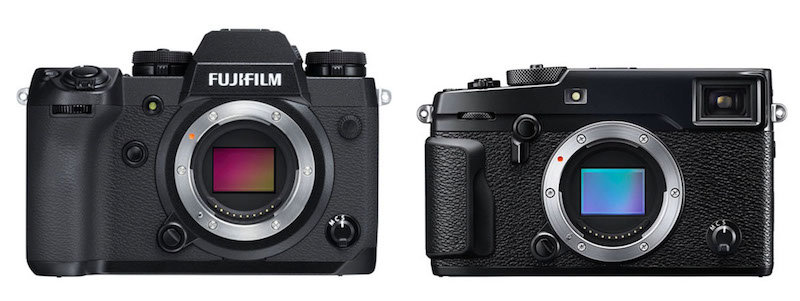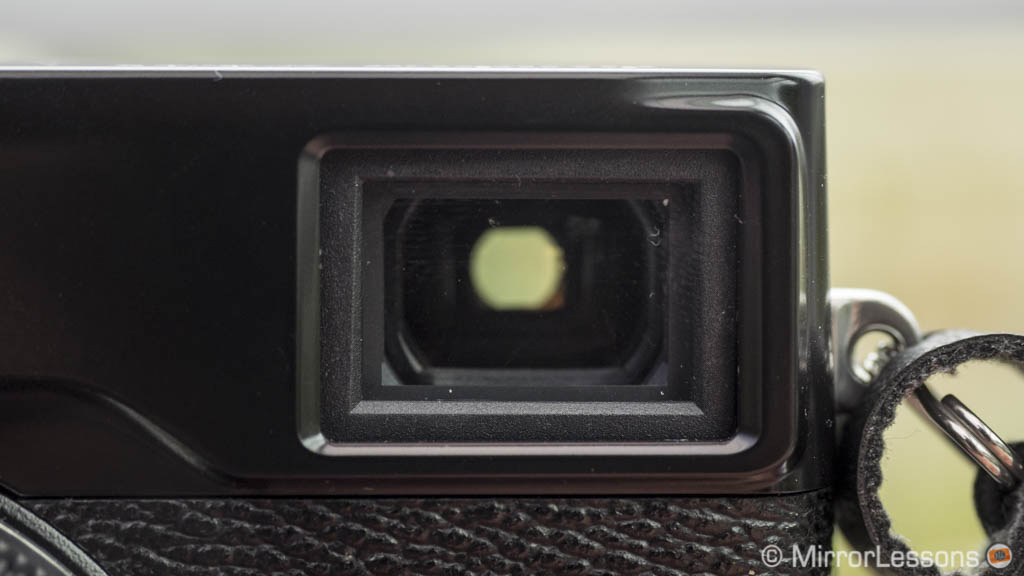The X-Pro2 was one of the most highly-anticipated products to come out of Fujifilm’s factory, arriving exactly four years after its much-loved predecessor, the X-Pro1. Even today, it remains a favourite amongst users who require digital features yet have a soft spot for the traditional rangefinder design.
The X-H1 is the latest X-Series camera and with its range of high-end features, takes its place above the X-Pro2 and X-T2 as the flagship model.
In this article you’ll find all the main differences between these two cameras, from the design to the various video specifications and features such as in-body stabilisation. Let’s begin!
What the X-H1 and X-Pro2 have in common:
- 24.2MP APS-C X-Trans III sensor and X-Processor PRO
- 200 to 12800 ISO (100, 25600, 51200 extended values)
- Hybrid AF system with 91/325 points and AF Custom Settings
- Shutter speeds (1/32000s with e-shutter / 1/8000s with mechanical shutter)
- Dual SD card slot
- NP-W126S battery
Ethics statement: The information supplied in this article is based upon official specifications and our personal experience with the X-Pro2 and other Fujifilm cameras. We were not asked to write anything about these cameras, nor were we provided with any sort of compensation. Within the article, there are affiliate links. If you decided to buy something after clicking the link, we will receive a small commission. To know more about our ethics, you can visit our full disclosure page. Thank you!
1. 5-axis in-body stabilisation system (IBIS)
5-axis in-body stabilisation is a feature you’ll find on almost all recent mirrorless cameras from Olympus, Panasonic and Sony. With the announcement of the X-H1, Fujifilm becomes the last of the main mirrorless manufacturers to embrace the technology.
According to the official specifications, the camera should offer compensation up to 5 stops with most stabilised and non-stabilised lenses. There are a few exceptions however. For example the performance increases by a small margin with the XF 35mm f1.4 (5.5Ev) but decreases with other lenses like the XF 18-55mm (3.5Ev).
The camera can use sensor and optical stabilisation by excluding select axes on the sensor and using Pitch and Yaw on the lens instead. Here again, the performance can vary depending on how advanced the OIS is of a specific lens.
Like all other X-Series models barring the X-H1, the X-Pro2 lacks in-body stabilisation, so if you often work hand-held in poor light, it would be a wise decision to invest in some Fujinon lenses with OIS.
2. 4K / Full HD video capabilities
The X-H1 is a more advanced video camera than the X-Pro2 in a number of ways.
First, it supports high video bitrate recording of 200Mbps for 4K / 30fps video and Cinema 4K / 24fps. It does so by slightly cropping the sensor (1.17x) which enables full pixel readout and crisper details. Also on offer is the “F-Log” log-gamma option first introduced on the X-T2. It can be recorded both internally to an SD card and externally via an HDMI port.
Finally in Full HD, the X-H1 can record slow motion footage in-camera at up to 120fps with a bitrate of 200Mbps.
When the X-Pro2 was first released, it could only record in Full HD (1920×1080) at a maximum of 60fps. However, thanks to firmware update 4.00 for the camera, it can now shoot in 4K at 30fps at a maximum bitrate of 100Mbps. 4K is recorded without cropping the sensor, so while the angle of view of the lens doesn’t change, the footage isn’t as sharp due to pixel binning.
3. Body design
The first difference you’ll notice is that the X-H1 has an SLR-like design with the viewfinder at the centre, while the X-Pro2 has a flat-topped rangefinder design with the viewfinder off to one side. (We’ll discuss the viewfinders in-depth in the next section!)

Both feature a solid weather-sealed construction (dust, splash and freeze proof) with a magnesium alloy chassis and metal finish, though that of the X-H1 is more robust thanks to its thicker scratch-resistant shell.
- X-H1: 139.8 x 97.3 x 85.5mm; 673g (with battery and SD card)
- X-Pro2: 140.5 x 82.8 x 45.9mm; 495g (with battery and SD card)
Concerning the size and weight, the X-H1 is taller due to its protruding viewfinder, deeper owing to its much larger grip out front, and heavier.
Although both cameras come with a dual SD card slot, only the X-H1 offers UHS-II compatibility for both. On the X-Pro2, only one slot is UHS-II compatible.
The controls of the two cameras are fairly similar: both make room for a large 3-inch LCD screen, various buttons, control dials on the front and rear, an AF joystick, and a D-Pad. However, only the X-H1 has the new AF-On button to activate the autofocus.
On top of the X-H1, you’ll find two dials (shutter speed and ISO) and a handy shoulder LCD that displays all the most important settings. The X-Pro2, by contrast, has an exposure dial and a combined ISO/shutter speed dial.

According to Fujifilm, the new “feather touch” shutter release button of the X-H1 responds better to delicate shutter release actions than those of previous X Series cameras. It also boasts a new shutter shock absorption mechanism that minimises camera shake risks to maximise the effect of image stabilisation.
Whereas the X-H1 has a microphone input and a headphone output on the vertical battery grip, the X-Pro2 only has a 2.5mm mini-connector. Both feature a Micro HDMI out and USB ports, but the X-H1 has a full 3.0 type.
There is a hot shoe for extra accessories but neither has a built-in flash.
4. Viewfinder technology
A unique feature of the X-Pro2 is its hybrid viewfinder. Using the front lever, you can switch between an optical and electronic viewfinder or activate the ERF (Electronic Rangefinder) in optical mode.

The OVF is a Reverse Galilean type with a field of view of 92%. The magnification varies from 0.36x to 0.6x. Included are bright frames to indicate the actual field of view of the lens and provide real-time parallax correction.
As for the EVF, it is a 0.48-inch TFT panel with 2.36 million dots of resolution, a 16mm eye-point, an 85fps refresh rate and 0.59x magnification.
On the X-H1, the viewfinder is 100% electronic. It is located at the centre of the body inside the viewfinder hump.
In comparison to the X-Pro2’s finder, it is larger (0.5 inch) with a higher magnification (0.75x) and more resolution (3.69 million dots). It has an eyepoint of 23mm and a maximum refresh rate of 60fps or 100fps with the Boost mode activated.
5. Rear LCD screen
Another feature that distinguishes the X-Pro2 from most other X-Series cameras is its fixed 3-inch LCD screen. (The majority have a tilting mechanism of some sort.) It has a resolution of 1.62 million dots and a 3:2 aspect ratio.

The X-H1’s screen is more versatile in a couple of ways.
First, it is a three-direction tilting type, which means it can tilt up and down when shooting in landscape orientation, or up when shooting portrait orientation.
Second, it is touch sensitive, so you can use it to focus, reposition the AF point or take a shot. It can activate up to four functions just like on the X-E3. In playback mode, functions include double-tapping to zoom in and out and swiping to view images.
Despite having the same aspect ratio, the resolution of the X-H1’s screen is lower (1.04 million dots) in comparison that of the X-Pro2.
6. Continuous shooting speeds and shutter
With the mechanical shutter, both the X-H1 and X-Pro2 can shoot as fast as 8fps (CH). Switch to CL (low mode), which gives you live view and blackouts, and the X-Pro2 is limited to 3fps while the X-H1 can reach 5fps (or 6fps with the EFCS).
The X-H1 has another advantage: with the electronic shutter, you can shoot at up to 14fps, and by attaching the vertical battery grip, it is possible to raise the maximum mechanical shutter speed to 11fps.
The maximum shutter speeds are the same: 1/8000s with the mechanical shutter or 1/32,000 with the electronic shutter.
7. Film Simulation Modes
The X-Pro2 comes with a total of fifteen Film Simulation Modes, which is the name Fujifilm gives its picture profiles.
The X-H1, being the latest flagship model, has an extra profile called ETERNA. Designed especially for video, it simulates cinematic film, creating understated colours and rich shadow tones.
8. Bluetooth 4.0
Unlike the X-Pro which only has Wifi connectivity, the X-H1 also incorporates Bluetooth 4.0 for faster and simpler image transfer. It enables a constant low-power connection with a smart device (iOS or Android), making it quick and easy to transfer your images.
The various actions you can perform via Bluetooth and WiFi are as follows: image transfer, viewing/obtaining images, remote control shooting, PC autosave, Instax printer print and geotagging.
9. Extra Features
There are a couple of features currently exclusive to the X-H1.
The first is the Flicker Reduction mode whose purpose is to deliver the right exposure even when shooting under artificial light.
Second is the EFCS (electronic first curtain shutter) which reduces shutter shock caused by vibrations from the mechanical shutter.
Finally there is the autofocus algorithm, which has been updated to process more data simultaneously in continuous AF.
10. VPB-XH1 vertical battery grip
I’ve made mention of the optional vertical battery grip (VPB-XH1) for the X-H1 throughout this article, which is why I feel it deserves a special mention here at the end.
Besides increasing the battery life and improving the ergonomics, it also enhances the performance of the AF speed, EVF refresh rate, shooting interval, shutter time lag, blackout time and high speed continuous shooting. For a professional shooting with the Fujifilm system, these are all very desirable improvements.
Because Fujifilm didn’t produce a battery grip for the X-Pro2, what you see is what you get – barring software updates via firmware of course.
Conclusion
Were I to choose between the two cameras for professional work, I would probably pick the X-H1 because I prefer the centrally-placed viewfinder, large grip and three-way tilting screen.
That being said, the X-Pro2 is definitely more distinctive thanks to its rangefinder design and advanced hybrid viewfinder. It may not be for everyone but it can offer a more unique user experience to those who embrace the concept.
The image quality should be more or less identical while the AF performance may prove superior on the X-H1 if the tweaks to the AF algorithm are as effective as Fujifilm claims.
Check the price of the Fujifilm X-H1 on
Check the price of the Fujifilm X-Pro2 on


